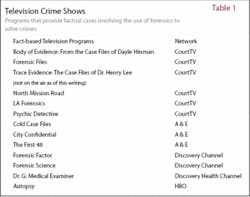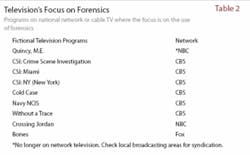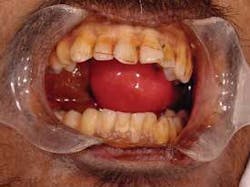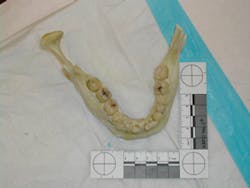FORENSIC dentistry
by Faith Y. Miller, CDA, RDH, MSEd
For those of us who are rabid fans of the CBS crime drama CSI: Crime Scene Investigation, the tune made famous by the rock band The Who immediately comes to mind. The immense popularity of this fictional television program set in Las Vegas has brought about a profound interest in the field of forensics.1 Interest in forensics began even before the trio of CSI: programs (set in Las Vegas, Miami, and New York) became so popular. Viewers of one of the early forensics shows tried to figure out the cause of death before Quincy, M.E., and his assistant Sam could. Television offers many fictional dramas where forensics is the focal point, as well as programs that present fact-based cases in which the collection of compelling forensic evidence helped solve some of the nation’s most horrific crimes (See Tables 1 and 2).
For dental hygienists who have a passion for forensics, there are several opportunities to get involved, depending upon specific interests. This article will highlight some of the components of forensics and explain how the dental hygienist may integrate one or more to assist them with identification of human remains, aspects of crime scene investigation, and the practice of documentation in patient records.
To begin, forensic science, or forensics, can be defined as: “the application of a broad spectrum of sciences to answer questions of interest to the legal system.”2
Forensic dentistry, or forensic odontology, is defined as: “the area of dentistry concerned with the correct management, examination, evaluation, and presentation of dental evidence in criminal or civil legal proceedings in the interest of justice.”3
The first and most obvious path to forensics for the dental hygienist is dentistry. Several courses in the dental hygiene curriculum help professionals become proficient in forensic dentistry. The dental hygiene student receives instruction in radiology, tooth anatomy and morphology, oral and general pathology, dental materials, anatomy and physiology, and even ethics and jurisprudence. Auxiliary dental professionals can apply what they learn in these courses to assist a forensic odontologist in retrieving evidence from victims and suspects of crimes where dental evidence is prominent.
A basic dental component of forensics is the collection and documentation of patient information. Dental hygiene students learn various charting and recordkeeping methods in school. Numerous continuing-education presenters and authors stress the importance of accurate documentation not just for a defensible, legal record of patient treatment, but ultimately to identify a missing person or in the defense or prosecution of fraud. Several dental professionals have also stressed the need to standardize charting and note-taking methods to ensure the readability and legibility of dental records that can assist in human identification.
A second aspect of forensics is anthropology. Anthropology is simply the study of humanity. Forensic anthropology, however, is the combination or application of physical anthropology and human osteology (study of the human skeleton) to help the law identify human remains that have been mutilated or burned. Prolific author Patricia Cornwell, who has penned such notable novels as The Body Farm, Cause of Death, and Blow Fly, focuses on West Virginia Chief Medical Examiner Dr. Kay Scarpetta as the central character. Ms. Cornwell began her career as an anthropologist. She has become a principal monetary donor of the Anthropological Research Facility, better known as “The Body Farm.” Research offices are located underneath the football stadium on the campus of the University of Tennessee, Knoxville, and are run by renowned forensic anthropologist William Bass, PhD. Dr. Bass has assisted in numerous cases that have led to the capture and subsequent conviction of criminals based upon his expertise in identifying persons from human remains as small as skull bone fragments to as large as the femur.
Dr. Bass has been featured on programs such as 60 Minutes and Court TV’s Forensic Files. By his own admission, he has advised Ms. Cornwell and is the impetus for the Lyall Shade character in her novels. The primary purpose of the facility is to monitor and record the time it takes for a body to decompose under various conditions with regard to temperature extremes, whether or not clothing is worn, and how quickly insects arrive at varying stages of decomposition.
This leads to a third branch of forensics - entomology. Can insects tell time? Perhaps not; but time, particularly time of death, can be determined by insects and their arrival to the corpse. Forensics can determine the time of death as the body begins to decompose by the type of insects that are on the body at the point of discovery. When and if time of death is called into question, conditions can be duplicated and an entomological timeline can be established. Figure 1 depicts the stages of decomposition in a piglet whose body was crushed and donated to science, according to information retrieved from the Australian Museum Online Web site.4
Prevalent in this timeline are temperature, whether the body was found indoors or outdoors, and if the body was found clothed or naked. The dental hygienist should concentrate heavily in the biological sciences if there is a strong interest in forensic entomology. In addition, study in this area, along with a strong background in chemistry, can lead to how bioterrorists can use insects to infest and destroy not only agriculture but invade humans by becoming vectors of deadly diseases.
When searching for additional educational or career opportunities, academic advisors might suggest anthropology as a way to blend interests. Dentistry and anthropology make a good team. Studying teeth the way the anthropologist does introduces a perspective that is different from that of the dental professional. There are courses in dental anthropology that dental hygiene students can take as electives.
Forensic photography is an element of crime scene investigation that requires the individual to “have a good grasp of photographic terminology and the skills for operating basic camera equipment.”5 Both still and digital photography are accepted methods; however, according to C. Michael Bowers, “Good photographic results are a minimum standard for every competent law enforcement agency. Poor crime scene photography will impact the quality and outcome of every forensic case and reflect negatively on everyone involved.”6 Given these specific parameters, the dental hygienist interested in this aspect of forensics should seek enrollment in photography courses and perhaps turn a popular hobby into a specialty that can be used to help identify the deceased or the perpetrator of a crime. Samples of forensic photography are shown in Figures 2 and 3.
A vast working knowledge of any of the above can be helpful in the event of a mass disaster where multiple fatalities pose a risk to the health and welfare of the public at-large. Many dental hygienists have found fulfillment working on DMORT (Disaster Mortuary Operational Response Team). DMORT is part of the Federal Emergency Management Agency (FEMA) and is called into action when the mishap produces catastrophic loss of life that is above and beyond what the local authorities can manage. DMORT units are composed not only of dentists and dental hygienists, but anthropologists, pathologists, DNA specialists, funeral directors, and embalmers. In fact, DMORT was created by funeral directors in response to massive flooding that unearthed thousands of graves in Hardin County, Mo. In that event, several bodies needed to be reidentified and reburied. 7 The ultimate goal of DMORT (according to its Web site) is to provide assistance to the victims’ families by: “assist[ing] in the identification and return of loved ones using the latest forensic techniques and with the utmost in reverence for the dead and compassion for the living.”8
If you are interested in forensic dentistry, here are some suggestions to get you started:
2 Wikipedia. Forensics defined. Retrieved July 15, 2006 from: http://en.wikipedia.org/wiki/Forensics.
3 Herschaft EE. Forensic dentistry. From Neville BW, Damm DD, Allen CM, and Bouquot JE., p. 763. Oral & Maxillofacial Pathology, 2nd Ed. W.B. Saunders Company: Philadelphia, 2002.
4 Australian Museum Online. Decomposition: What happens to the body after death? Retrieved July 15, 2006 from: http://www.deathonline.net/decomposition/decomposition/index.htm.
5 Wright FD, Golden GS. Forensic photography. From Stimson PG & Mertz CA., p.101. Forensic Dentistry 1997; CRC Press, LLC: Boca Raton, Fla.
6 Bowers CM. Forensic dental evidence: an investigator’s handbook, p. 192. Elsevier Academic Press: San Diego, Calif., 2004.
7 Sledzik PS, Willcox AW. Corpi aquaticus: The Hardin cemetery flood of 1993. From Stedman DW, p. 256-264. Hard Evidence: Case Studies in Forensic Anthropology 2003; Prentice Hall: Upper Saddle River, N.J.
8 DMORT. The families of victims. Retrieved July 15, 2006 from: http://www.dmort.org/DNPages/DMORTFamily.htm.Internet resources









